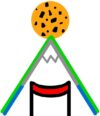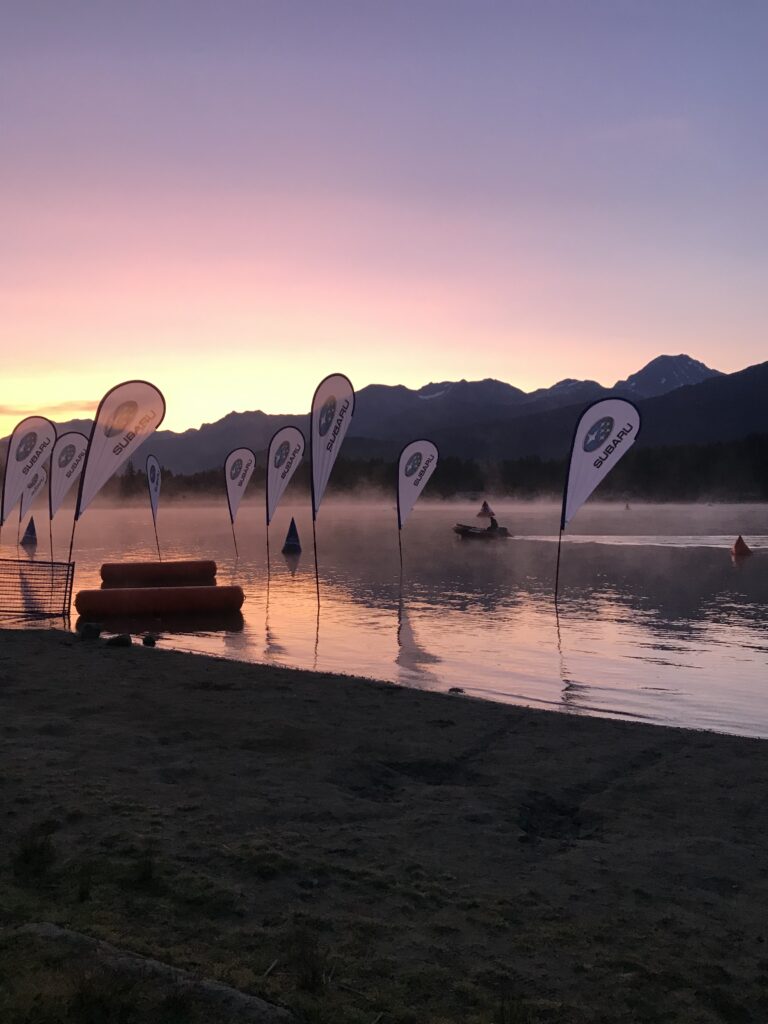I keep putting off writing a real race report for a few reasons: I’m not sure what to share, and I’ve never written a “real” race report before. But here’s my attempt:
First, many thanks to all the volunteers who manned the course. We could not have done what we did without you. Your smiles and enthusiasm kept me going. I also want to thank my boyfriend, my friends, and the people I met at the race for their support, inspiration, and generosity (I forgot my bodyglide on race day). Finally, many thanks to Whistler for hosting a race in such a beautiful place. I will never forget the morning fog rising from the lake before the swim or the snowcapped mountains providing backdrop for the bike and run.
To me, the Ironman lasted more than just the fourteen and three quarters hours it took to finish. In order to understand my race mentality, it makes sense for me to give some background before the official race report.
Prerace
In April, I was standing for long hours at a time, shifting my stance every so often but unable to shake a persistent pain in my right foot. It was not until June that I figured out I’d stress fractured my calcaneous. I hadn’t been running or really biking since March but by not properly resting my foot the fracture had persisted. I was given a boot, but it was still painful to walk, and I started using crutches. Two weeks later, I ditched the crutches and boot, started biking again, started erging (I was a rower in college), and started pushing off the walls at the pool. This was perhaps a premature move, but I started slowly and carefully monitored the pain. I was able to increase my training to a max swim of 4500m, max bike ride of 88 miles, and max run of 6 miles by mid-July (the Ironman took place on July 28, and my longest run previously had been 22 miles in January). Perhaps a naïve view, but I told myself that the training had in fact been going on my whole life and that despite my spotty workouts for the past half year, the years of collegiate rowing I’d done gave me an irrevocable mental and physical base that would carry me to the finish line. The 6-mile run had re-stressed my foot, and a week before the race I was distraught, back on crutches, trying desperately to rest my foot as much as possible until the day of. My plan for the marathon had been to do 3.5 mins walking/1.5 mins running, but now it was to wear the boot and walk the whole thing.
Two days before the race, I asked the race director about leaving my boot at special needs and being able to retrieve it after the race. She gave me a look and an incredulous “have you even thought about what you’re about to do?” I probably deserved this, but it stung nonetheless and gave me even more resolve to prove I had thought about it and was going to do it. The day before the race, on the bus ride back from T1, I met someone who told me his friend had completed an Ironman a few months after having knee surgery, basically dragging his leg through the marathon. Not that that was a good idea, but it did give me hope that finishing was possible and that walking late into the night was a different sort of Ironman experience (and one worth experiencing) than finishing more quickly, as had been my original goal.
Official Race Report
Okay, now for the “official race report:” The day of, I woke up at 2:12am to pee and freak out. I woke up for real at 4am. I had eaten two pieces of toast with almond butter and banana and was ready to go by 4:20, before the guys I was staying with, but we all headed out together around 4:35. This was fair timing, but I didn’t get to go pee before the swim, so I had to pee the whole time. I finally peed on the bike, which made me feel really legit. I had an amazing swim, though my sighting could be improved, and placed first in my age group with a time of just under 1:05. I wore my bike gear, one of my friend’s UCSF singlet, under my wetsuit. I wanted to bike for my friend—he’d had an awful fall during the Death Ride a couple weeks prior, though thankfully sustained what seems like no permanent injury. My bike split was way faster than I’d imagined it’d be with a time of around 6:45 (my goal was 8:30 haha… elevation gain was about 8000ft). It was so gorgeous, but I was jealous of people with aerobars and fancy bikes. A bee flew into the top of my singlet and stung my chest as I frantically shooed it away. I thought bee stings were supposed to hurt, but I guess I was so caught up in biking I barely noticed it! The first lap felt so good and my legs felt great. I scouted all the places my waterbottles might fall out of their racks (which happened once) so on the second lap I could protect them. The second lap the climbs and even the descents against the wind were tough, but I came into T2 feeling fresher than I’d anticipated. Perhaps it was the two bottles of Gatorade I’d added to my nutrition plan on race day (maybe it’s okay to try new things on race day) or maybe it was the week of taper. Too bad running was not in my game plan.
The marathon deserves its own paragraph. The last 10 miles of the bike my right knee had started hurting, and it got so much worse walking with the boot on, so I took off the boot around 8 miles in and carried it just in case. Luckily my foot didn’t hurt at all the rest of the way, or maybe it did but the knee pain dwarfed it magnificently, I’ll never know. All I did was breathe in my nose and out my mouth. When next to a lake, I drew upon to its quiet force. Seeing the strong mountains and trees, I drew strength from them too. And I looked forward to the next time I’d see my friends, spectators, or volunteers cheering for me. At one point I thought, could be worse: could be that my foot hurts and my knee hurts and I have shin splints. Then of course a mile later I started feeling the shin splints. But maybe those (oh and the blisters on the soles of my feet) helped distract me from the knee pain. People kept telling me I was inspiring and amazing and a “tough cookie,” and I ended up getting named “boot girl” by spectators. But I really wondered whether I should be encouraged or not. After all, I could have caused permanent foot or knee damage. Maybe I did—only time will tell. Anyway, I somehow miraculously made it through speed walking all 26.2 miles in about 6:45. My one regret was declining an offer of warm chicken broth from a friendly volunteer at an aid station with two miles left. I was too narrow-mindedly focused on the finish to fully enjoy the last part of the journey.
Postrace
Though the Ironman ends when you pass the finish line, the pain from the race does not. I learned this the hard way: I wildly believed that all the pain would end when I finished, and this may have driven me to the finish line, but it was certainly not reality. I hobbled and crutched around for the week after the race, unable to bend my swollen knee, and had constant shin pain. Advil and ice work wonders though because now, a week and a half later, I can walk on my own two feet again! No foot pain too, miraculously. (I’m also not endorsing racing with an injury, but all injuries are different and race plans can be adapted.)

